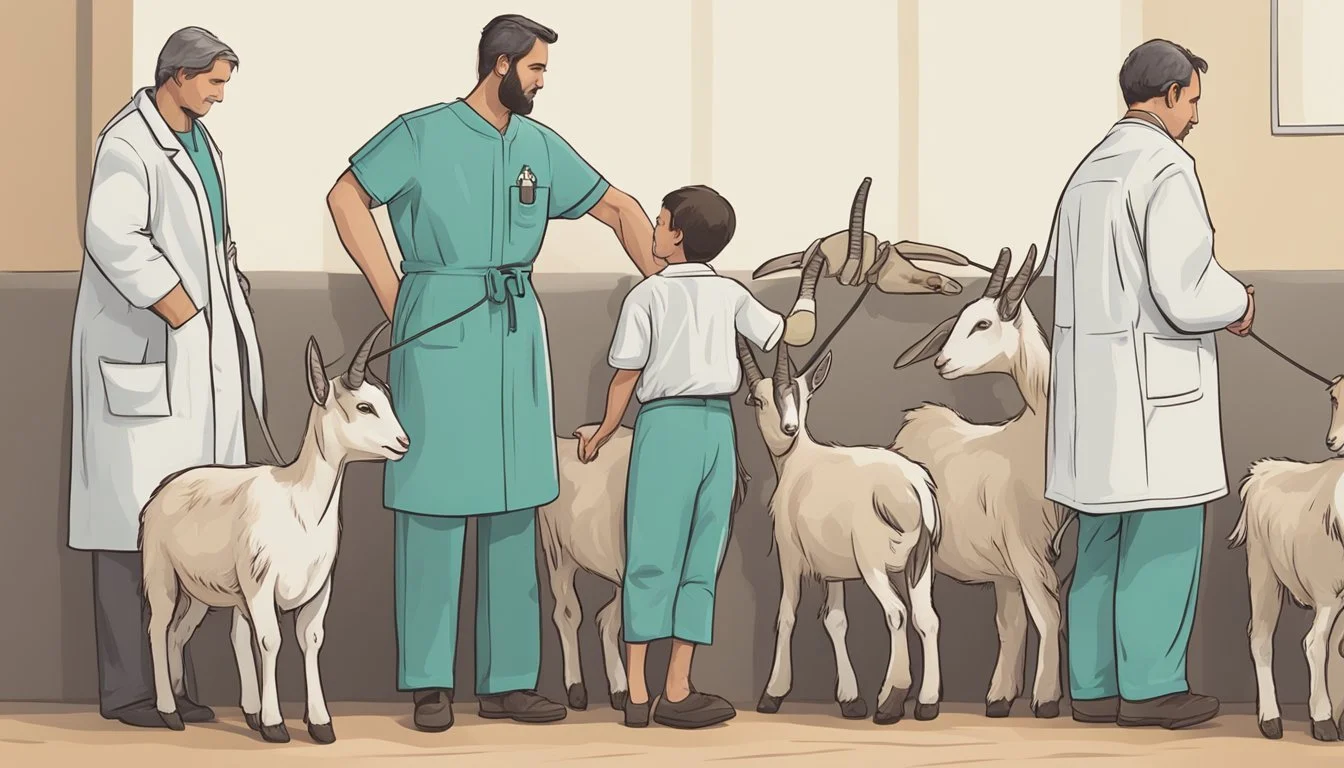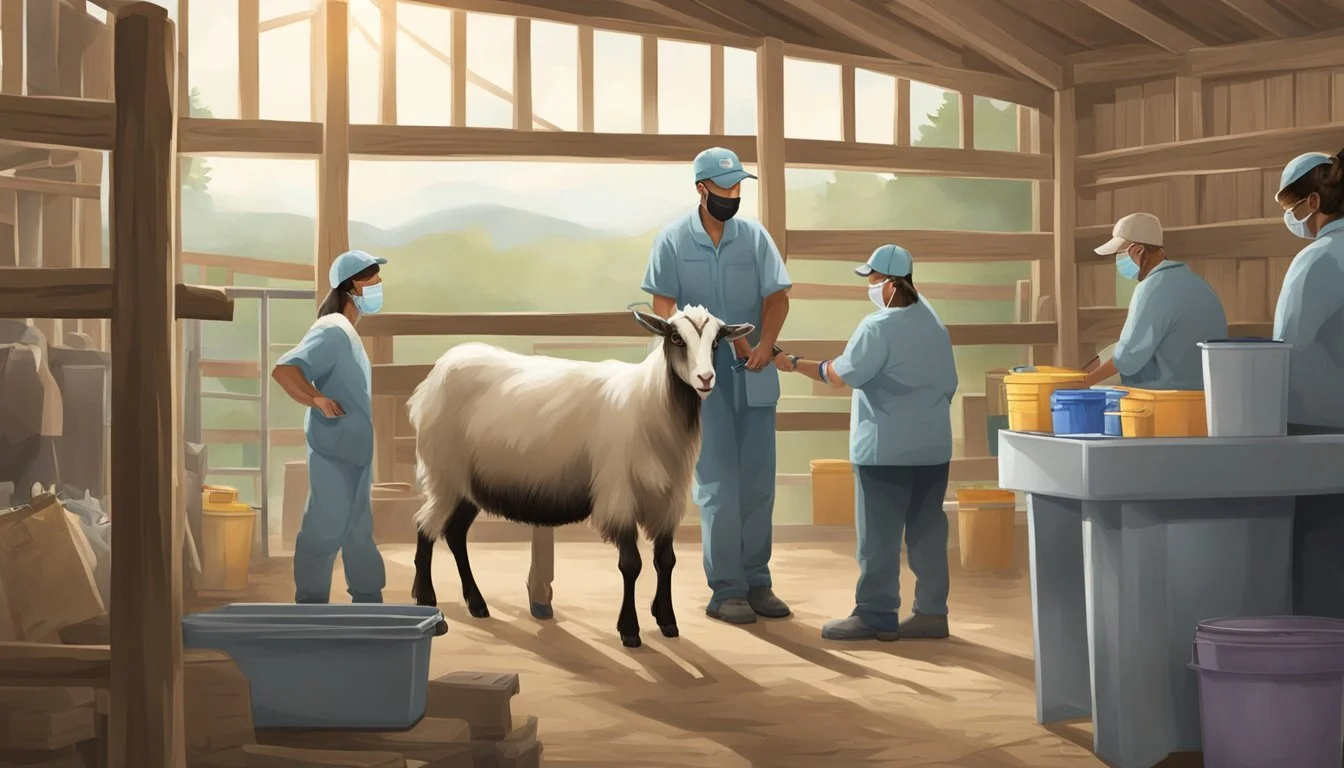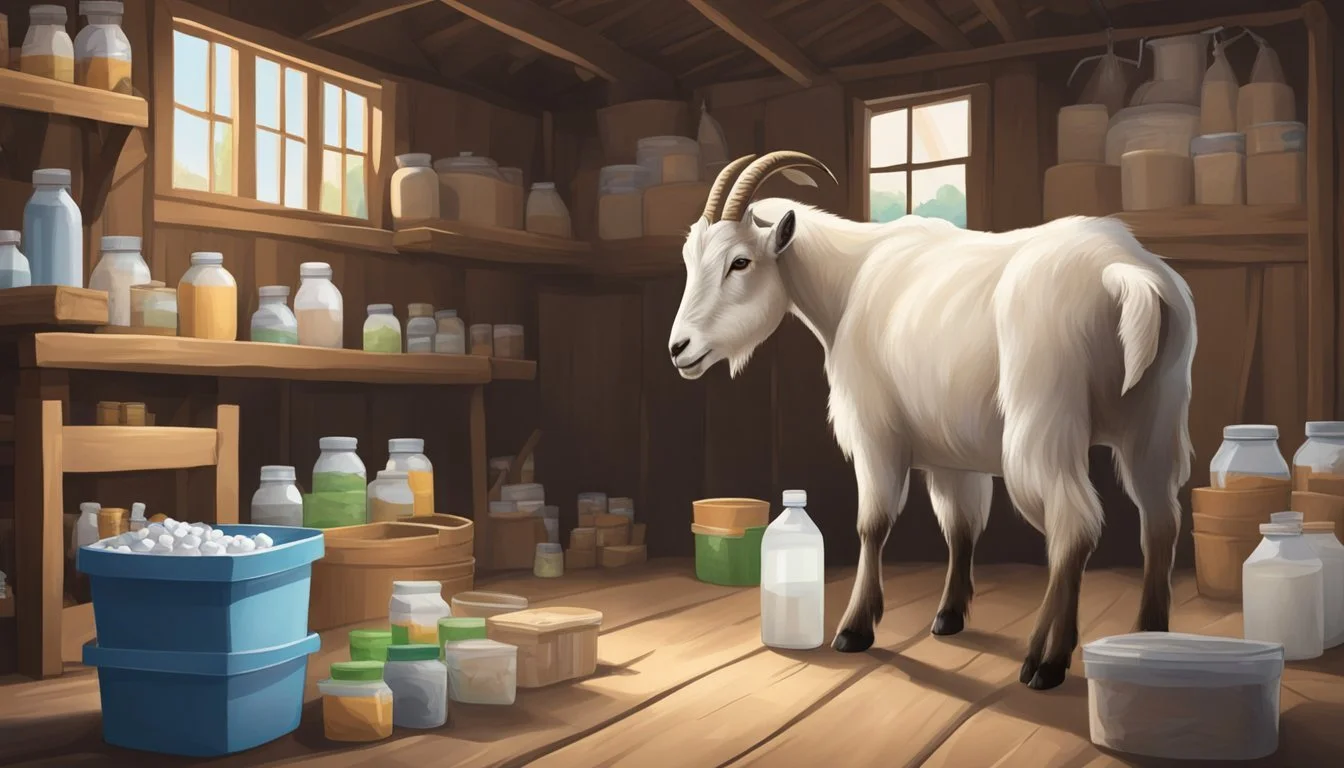Essential Vaccinations for Your Family Milking Goat
A Guide to Protecting Your Herd
Maintaining the health of milking goats is vital for the well-being of the herd and the safety of the milk they produce. Goats, like other livestock, are prone to certain diseases that can be effectively prevented through vaccinations. Immunizations play a critical role in herd health management by providing individual goats with protective antibodies against various infectious diseases. Moreover, vaccines not only protect the vaccinated animal but also help to reduce the spread of pathogens throughout the herd, contributing to overall herd immunity.
When it comes to the family milking goat, there are several essential vaccinations that are necessary to ensure the animal's health and productivity. Vaccines for Clostridium perfringens types C and D along with tetanus, commonly known as the CD-T vaccine, are considered core vaccinations for milking goats and should be administered according to the recommended schedule. These vaccines help to prevent common diseases such as enterotoxemia and tetanus, which can be fatal if left untreated. It is also critical to adhere to the appropriate vaccination schedule, including initial immunizations and regular boosters, to sustain immunity over time.
While core vaccines are generally recommended for all goats, optional vaccines may be considered depending on the geographic location, the herd's specific needs, and the prevalent diseases in the area. For example, in certain regions, autogenous bacterins may be used to target specific pathogens affecting the local goat population. It's essential to consult with a veterinarian to create a tailored vaccination plan that aligns with the unique requirements of the family milking goat.
Essential Goat Vaccination Overview
Proper vaccination is critical for maintaining a herd's health, especially for family milking goats, safeguarding against infections like Clostridial diseases, Caseous lymphadenitis, and other life-threatening ailments.
Understanding Vaccination and Immunity
Vaccination is the administration of a vaccine to stimulate an animal's immune system to develop immunity to a specific pathogen. When goats are vaccinated, they are injected with a weakened or killed form of a disease-causing microorganism or a piece of that organism. This stimulates the goat's immune system to recognize the pathogen as a threat, destroy it, and "remember" it, so that the immune system can more easily recognize and combat the pathogen in future encounters.
Key Vaccines for Goats:
CDT (Clostridium perfringens types C and D + Tetanus Toxoid): Protects against enterotoxemia, also known as overeating disease, and tetanus.
Pneumonia Vaccines: Typically covers Pasteurella and other agents that cause pneumonia.
Caseous Lymphadenitis Vaccine: Helps prevent this highly contagious bacterial disease.
Common Goat Diseases and Preventable Ailments
Goats are susceptible to a variety of diseases, many of which can be prevented through regular vaccinations.
Enterotoxemia (Overeating Disease): Caused by Clostridium perfringens types C and D, vaccination can prevent this deadly disease, which is often triggered by sudden changes in a goat's diet.
Tetanus (Lockjaw): A potentially fatal disease that affects the nervous system, but can be avoided with the tetanus toxoid vaccine.
Pneumonia: A serious respiratory condition that can be minimized with vaccines targeting the causative agents, often including Pasteurella.
Caseous Lymphadenitis: A chronic infection that can be significantly reduced with proper vaccination protocols.
Clostridial Diseases including other forms such as blackleg and pulpy kidney are preventable through multivalent vaccines. Vibriosis, a reproductive disease, can also be addressed through vaccination in some cases. Regular consultation with a veterinarian will ensure that vaccination schedules are tailored to the specific needs of a goat herd, taking into account regional diseases and the farm's management practices.
Vaccination Types and Schedules
Establishing a proper vaccination schedule is crucial for the health of family milking goats. One must adhere to core vaccine guidelines and consider optional vaccines based on regional threats while maintaining accurate records throughout the vaccination program.
Core Vaccines for Family Milking Goats
The cornerstone of any milking goat's health regimen includes vaccines for Clostridium perfringens types C and D and tetanus. These are critical to protect against common fatal diseases such as enterotoxemia and 'over-eating disease’. Goats should receive these vaccines annually. The typical administration involves an initial vaccine followed by a booster, usually 4 to 6 weeks apart. Pregnant does require vaccinations 2-4 weeks before kidding to ensure passive immunity to the kids.
Optional Vaccines and Region-Specific Needs
In addition to the core vaccines, there are optional vaccines for diseases like rabies, which is required by law in some areas. For instance, New York mandates that only a veterinarian can administer the rabies vaccine. Vaccines for chlamydia and campylobacter, which cause reproductive issues, are important if these diseases are prevalent in the area. It's imperative to consult with a local veterinarian to customize vaccine choices according to regional risks.
Administering the Vaccination Program
As part of the vaccination program, it's important to use a new needle for each goat to prevent disease transmission and cross-contamination. Always follow the vaccine label for instructions on dosage and withdrawal times for meat and milk. Keeping detailed records of vaccination dates, types, and any reactions is vital. Labels will also indicate whether a particular vaccine is safe to use in pregnant goats.
Always check with local laws and veterinarians for the latest vaccination advice and to confirm the vaccination schedule.
It's crucial to note that meat withdrawal should be considered depending on the vaccine administered.
Vaccines should be stored and handled according to the label instructions to ensure their efficacy.
Steps for Proper Vaccine Administration
Proper vaccine administration is crucial for the health of your family milking goat. Careful preparation, correct administration techniques, and diligent post-vaccination monitoring ensure the safety and efficacy of the vaccines.
Preparing the Vaccines for Administration
Before administering vaccines, one needs to ensure they are stored at the recommended temperature to maintain effectiveness. Vaccines should be refrigerated and not frozen. It is optimal to let a vaccine reach a bit above refrigerator temperature before use, yet it must remain cool; thus, timing is key. Each vial should be inspected for expiration dates and signs of contamination. Prior to drawing the vaccine into the syringe, an alcohol wipe should be used to clean the top of the vial. Sterile needles and syringes are essential; a new needle should ideally be used for each goat to prevent disease transmission. The size of the needle is also important; typically, a 22 to 25 gauge needle is appropriate for small ruminants like goats.
Vaccine Administration Techniques
Administering vaccines to goats involves choosing the correct injection site and method. Options include intramuscular (IM) and subcutaneous (SC or subQ) injections. For IM injections, common sites include the muscular areas of the thigh or neck, ensuring to avoid blood vessels and nerves. SC injections are given under the skin, usually in the neck area. When giving either an IM or SC injection, the site should be clean and an alcohol wipe may be used beforehand. The syringe must be held steady, and the vaccine should be injected at the correct angle: 90 degrees for IM and 45 degrees for SC injections.
Post-Vaccination Monitoring and Records
After administering the vaccine, the goat should be observed for any adverse symptoms such as swelling, pain, or lethargy, which could indicate a reaction to the vaccine. The individual who administers the vaccine should keep detailed records of each vaccination. This includes the date, type of vaccine, lot number, administration site, and any reactions observed. Maintaining accurate health records helps track the goat's vaccine history and schedule future vaccinations efficiently.
Management Practices Complementing Vaccinations
In addition to vaccinations, a comprehensive approach to health management in family milking goats hinges on meeting their nutritional requirements and carefully managing their breeding and reproductive health. These practices are vital to boost immunity and combat diseases such as mastitis, enhancing the overall well-being of does and bucks.
Nutritional Requirements for Optimal Health
Proper nutrition is critical for improving a goat's resistance to diseases and maximizing the efficacy of vaccinations. Goats require a balanced diet rich in:
Vitamins
Minerals
Carbohydrates
Proteins
Fats
It is imperative that lactating does receive a diet formulated to meet the demands of milk production and recovery post-kidding. For instance, providing plenty of high-quality forage and a mineral supplement can prevent nutrient deficiencies that weaken the immune system and can lead to health issues. Incorporating colostrum management directly after birth ensures the transfer of essential antibodies to offspring, fortifying their immune systems from the start.
Breeding and Reproductive Health
Effective breeding and reproductive health protocols support the efficacy of vaccination programs. They must include:
Regular health screenings for reproductive diseases
Isolating and treating infected animals, particularly to prevent the spread of mastitis in milking goats
Timely vaccinations, especially in pregnant does, to provide protective colostrum to newborns
Selecting breeding stock for genetic traits such as disease resistance is also advisable. High-quality bucks and does should be chosen to foster strong offspring with robust health. The breeding schedule should be carefully planned to ensure that ewes and does are in optimal condition and not under stress, which can impact immunity.
Goat Care and Monitoring for Disease Prevention
Proactive care and consistent monitoring are critical components in preventing diseases in goats. An environment conducive to health coupled with regular health evaluations helps keep the goat herd in optimal condition.
Environmental Factors Affecting Goat Health
Factors such as barn cleanliness and pasture maintenance can significantly impact a goat's health. Temperature and humidity control are paramount in preventing respiratory issues and minimizing stress that could lead to inflammation. Goats require well-ventilated living areas to reduce the buildup of ammonia and moisture, which are conducive to bacterial growth and therefore disease.
Barn: Should be kept clean with regular removal of manure to prevent bacteria growth and reduce the risk of disease. Proper ventilation is crucial to maintain air quality.
Bedding: Must be dry and regularly changed to prevent the development of skin wounds and mastitis-inducing bacteria.
Pasture: Regularly rotated to minimize parasite load and to allow for regrowth and recovery. Overgrazing can lead to malnutrition and increased exposure to parasites, both of which can compromise a goat's immune system.
Routine Health Checks and When to Seek Veterinary Assistance
Regular health checks are a preventive measure that enables early diagnosis and treatment of potential issues. Such checks should include observation for physical abnormalities, changes in behavior indicating discomfort or illness, and signs of common diseases such as mastitis.
Vital Signs: Check the goat's temperature, pulse, and respiration rates. A fever may indicate infection or inflammation.
Udder Health: Inspect udders for signs of mastitis, which may include swelling, heat, redness, or abnormal milk.
Wounds: Examine for any cuts or wounds that could become infected if left untreated.
Medications: Ensure a supply of basic medications recommended by a veterinarian is on hand for immediate treatment when needed.
Should a goat exhibit persistent symptoms or if a disease is suspected, seeking veterinary assistance promptly is essential for a proper diagnosis and to determine the most effective treatment. Veterinarians can also advise on disease prevention strategies and help develop a plan to manage or even establish resistance to common diseases through preventive care, including vaccinations.
Additional Health Measures for Disease Control
Beyond essential vaccinations, controlling disease in a family milking goat operation requires stringent health measures. Implementing effective quarantine, isolation, hygiene, and sanitation practices are vital for preventing the spread of diseases like lice, worms, and foot rot.
Quarantine and Isolation Practices for New or Sick Goats
When new goats are introduced to a herd or when individuals fall ill, quarantine and isolation are crucial steps to minimize infection risks.
Quarantine: New goats should be quarantined for at least 30 days before integrating with the herd. This allows for observation for signs of contagious diseases, parasites, or other health issues.
Isolation: Sick goats must be isolated immediately to prevent the spread of diseases like foot rot, which can quickly affect an entire herd. Protective wear should be used by handlers to avoid cross-contamination.
Importance of Cleanliness and Hygiene in Goat Rearing
Maintaining cleanliness is fundamental to disease control in goat rearing. Regular cleaning and disinfection of the living quarters are essential to eliminate infection sources.
Clean Bedding: Replace bedding often to reduce the risk of external parasites such as lice and mites.
Disinfection: Use appropriate disinfectants in living areas, especially where there has been an outbreak.
Pest Control: Implementing a consistent pest control program helps to prevent infestations that can cause or carry diseases.
Regular Health Checks: Frequent health assessments help to identify issues like worms early, allowing for timely treatment and control measures.
By focusing on proactive health management strategies, goat owners can create a healthier environment for their animals and ensure the production of safe, high-quality milk.
Commonly Asked Questions and Concerns
Family milking goats require specific care, and vaccinations form a crucial part of their health regimen. Commonly, goat owners have questions regarding side effects and the administrative aspects of vaccination, such as withdrawal times and certificates.
Dealing with Common Side Effects and Complications
When goats receive vaccinations, it's not uncommon for them to experience some side effects. The most typical is inflammation at the injection site, which can manifest as swelling or soreness. A toxoid is used to induce immunity, while an antitoxin provides immediate protection against toxins released by bacteria, often part of a goat's vaccination schedule.
Mild Reactions: Small, temporary swellings at the injection site are common and typically resolve without intervention.
Serious Reactions: In the rare event of a severe reaction, immediate veterinary attention is critical. Signs to watch for include difficulty breathing, severe inflammation, or systemic illness.
Understanding Withdrawal Times and Vaccination Certificates
Withdrawal times are a period during which the milk from the vaccinated goat should not be used for human consumption. These times ensure that any toxins or medication residues are not present in the milk.
Withdrawal Periods: Strictly adhere to the manufacturer's guidelines on withdrawal intervals to ensure milk safety.
Certification: Keeping up-to-date vaccination certificates may be required for transportation, sale, or participation in fairs.
By being attentive to the side effects and the administrative needs of vaccinating your family milking goats, owners can ensure the health and productivity of their herd.
Advanced Topics in Goat Vaccination
The realm of goat vaccination is multi-faceted, encompassing practical issues of vaccine storage and stability, ongoing advancements in immunization research, and the intricate ethical and legal implications of administering vaccines. Each area directly impacts the efficacy of the vaccination program, symptoms management, productivity, and overall animal health.
Vaccine Storage and Stability Issues
Vaccines must be stored at correct temperatures to ensure their potency and prevent spoilage. For instance, most vaccines need to be kept refrigerated between 2°C and 8°C (35°F and 46°F). A vaccination's effectiveness can degrade if exposed to higher temperatures or if it freezes, which may alter its ability to appropriately immunize the animal. It is vital to regularly check refrigeration units with a thermometer and to keep vaccines away from the freezer compartment. The vaccine label typically offers specific storage instructions that must be meticulously followed.
Innovations and Research in Goat Vaccinations
Research in goat vaccinations is continuously evolving to enhance animal health and farm productivity. Currently, there is a growing interest in developing multivalent vaccines, capable of protecting against multiple diseases in one administration. Recent studies have focused on assessing the efficacy of vaccines not originally intended for goats, such as the Merial sheep rabies vaccine (Imrab®), and adjusting the dosage and administration protocols to maximize benefits for goats.
Ethical and Legal Considerations in Vaccination
Vaccinating goats brings forth ethical considerations regarding animal welfare. It is pivotal to vaccinate to prevent disease outbreaks, which can cause considerable suffering and death amongst livestock. Legal aspects are also key; certain vaccines, like the rabies vaccine, can only be administered by a licensed veterinarian, and failing to properly document a vaccination could result in non-recognition of the animal's vaccinated status in official terms. The actual vaccination process must be performed while adhering to all animal welfare guidelines to ensure it is carried out humanely.









